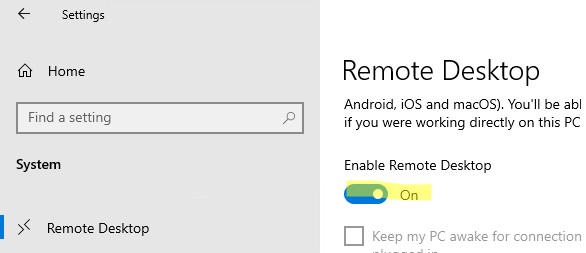Удаленные пользователи могут подключаться к своим компьютерам Windows 10 или 11 через службу удаленных рабочих столов (RDP). Достаточно включить удаленный рабочий стол (Remote Desktop), разрешить RDP доступ для пользователя и подключиться к компьютеру с помощью любого клиента удаленного рабочего стола. Однако в десктопных версия Windows есть ограничение на количество одновременных RDP сессии. Разрешается только один активный Remote Desktop сеанс пользователя.
Если вы попробуете открыть вторую RDP сессию, появится предупреждение с запросом отключить сеанс первого пользователя.
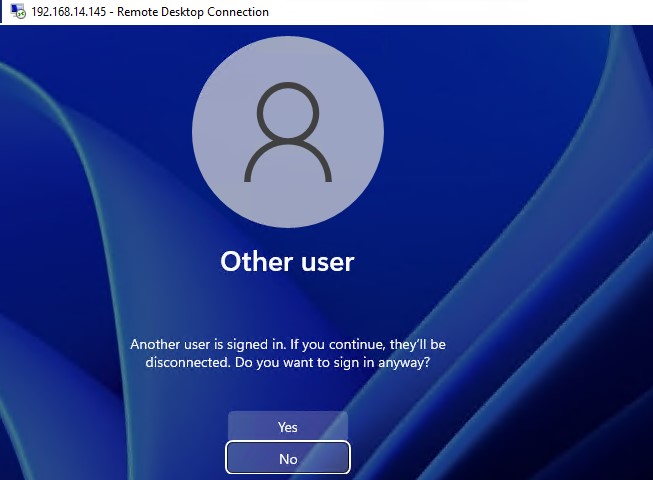
В систему вошел другой пользователь. Если вы продолжите, он будет отключен. Вы все равно хотите войти в систему?
В английской версии предупреждение такое:
Another user is signed in. If you continue, they’ll be disconnected. Do you want to sign in anyway?
Содержание:
- Ограничения на количество RDP сессий в Windows
- RDP Wrapper: разрешить несколько RDP сеансов в Windows
- Не работает RDP Wrapper в Windows
- Модификация файла termsrv.dll для снятия ограничений RDP в Windows 10 и 11
- Встроенная поддержка нескольких RDP сессий в редакции Windows 10 Enterprise Multi-session
Ограничения на количество RDP сессий в Windows
Во всех десктопных версиях Windows 10 и 11 есть ряд ограничений на использование служб удаленного рабочего стола
- Разрешено удаленно подключаться по RDP только к редакциям Windows Professional и Enterprise. В домашних редакциях (Home/Single Language) RDP доступ запрещен;
- Поддерживается только одно одновременное RDP подключение. При попытке запустить вторую RDP-сессию, пользователю будет предложено завершить активный сеанс;
- Если пользователь работает за консолью компьютера (локально), то при удаленном подключении по RDP, его локальный сеанс будет отключен (заблокирован). Также завершается и удаленный RDP сеанс, если пользователь входит в Windows через консоль компьютера.
Ограничение на количество одновременных RDP подключений в Windows является не техническим, но программным и лицензионным. Таким образом Microsoft запрещает создавать терминальный RDP сервер на базе рабочей станции для одновременной работы нескольких пользователей.
Если ваши задачи требуют развертывание терминального сервера, Microsoft предлагает пробрести Windows Server (по умолчанию разрешает 2 активных RDP подключения). Если вам нужно большее количество одновременных сессий пользователей, нужно приобрести лицензии RDS CAL, установить и настроить роль Remote Desktop Session Host (RDSH) или полноценную RDS ферму.
Технически любая редакция Windows при наличии достаточного ресурсов оперативной памяти и CPU может обслуживать одновременную работу нескольких десятков удаленных пользователей. В среднем на одну RDP сессию пользователя требуется 150-200 Мб памяти (без учета запускаемых приложений). Т.е. максимальное количество одновременных RDP сессий в теории ограничивается только ресурсами компьютера.
В этой статье мы покажем три способа убрать ограничение на количество одновременных RDP подключений в Windows 10 и 11:
- Использование RDP Wrapper
- Модификации системного файла termsrv.dll
- Апгрейд до редакции Windows 10/11 Enterprise for virtual desktops (multi-session)
Примечание. Все модификации операционной системы, описанные в этой статье, считаются нарушением лицензионного соглашения Windows, и вы можете использовать их на свой страх и риск.
Прежде, чем продолжить, проверьте что в настройках Windows включен протокол Remote Desktop.
- Откройте панель Settings -> System —> Remote Desktop -> включите опцию Enable Remote Desktop;
- Либо воспользуйтесь классической панель управления: выполните команду SystemPropertiesRemote -> Перейдите на вкладку Remote Settings (Удаленный доступ), включите опцию Allow remote connection to this computer (Разрешить удалённые подключения к этому компьютеру).
RDP Wrapper: разрешить несколько RDP сеансов в Windows
Open-source утилита RDP Wrapper Library позволяет разрешить конкурентные RDP сессии в Windows 10/11 без замены системного файла termsrv.dll.
RDP Wrapper работает в качестве прослойки между менеджером управления службами Service Control Manager, SCM) и службой терминалов (Remote Desktop Services). RDP Wrapper не вносит никаких изменений в файл termsrv.dll, просто загружая termsrv с изменёнными параметрами.
Важно. Перед установкой RDP Wrapper важно убедится, чтобы у вас использовалась оригинальная (непропатченная) версия файл termsrv.dll. Иначе RDP Wrapper может работать не стабильно, или вообще не запускаться.
Вы можете скачать RDP Wrapper из репозитория GitHub: https://github.com/binarymaster/rdpwrap/releases (последняя доступная версия RDP Wrapper Library v1.6.2). Утилита не обновляется с 2017 года, но ее можно использовать на всех билдах Windows 10 и 11. Для работы утилиты в современных версиях Windows достаточно обновить конфигурационный файл rdpwrap.ini.
Большинство антивирусов определяют RDP Wrapper как потенциально опасную программу. Например, встроенный Microsoft Defender антивирус классифицирует программу как PUA:Win32/RDPWrap (Potentially Unwanted Software) с низким уровнем угрозы. Если настройки вашего антивируса блокируют запуск RDP Wrapper, нужно добавить его в исключения.
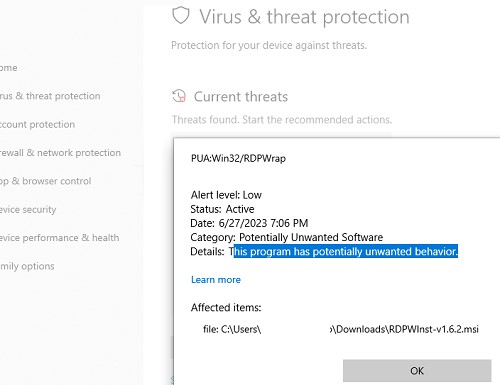
Архив RDPWrap-v1.6.2.zip содержит несколько файлов:
- RDPWinst.exe —программа установки/удаления RDP Wrapper Library;
- RDPConf.exe — утилита настройки RDP Wrapper;
- RDPCheck.exe — Local RDP Checker — утилита для проверки RDP доступа;
- install.bat, uninstall.bat, update.bat — пакетные файлы для установки, удаления и обновления RDP Wrapper.
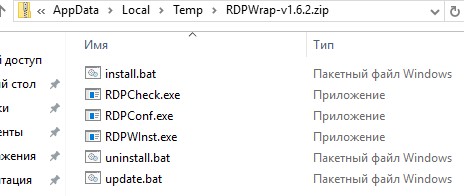
Чтобы установить RDPWrap, запустите файл
install.bat
с правами администратора.
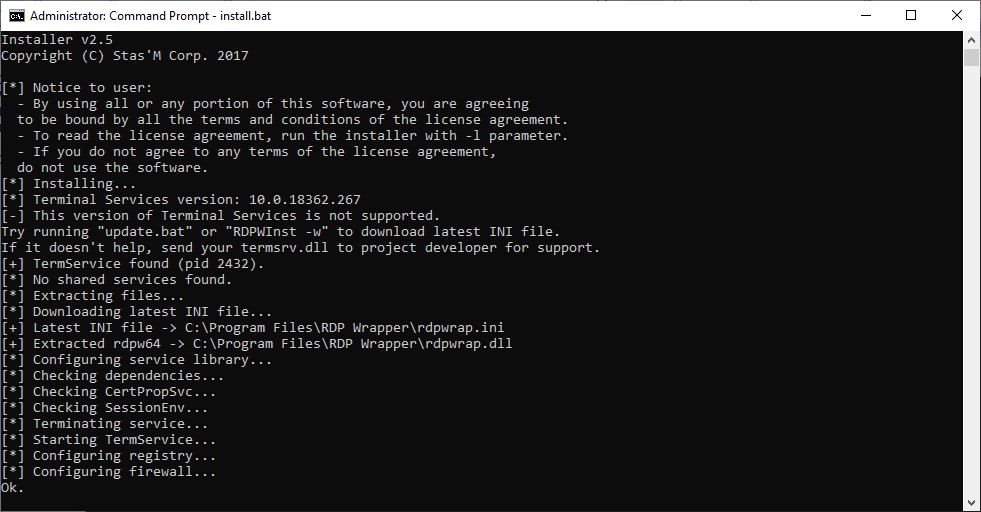
После окончания установки запустите RDPConfig.exe.
![rdp-wrapper: красная надпись не поддерживается [not supported]](https://winitpro.ru/wp-content/uploads/2015/09/rdp-wrapper-ne-podderzhivaetsya.jpg)
Скорее всего сразу после установки утилита покажет, что RDP wrapper запущен (Installed, Running, Listening), но не работает. Обратите внимание на красную надпись. Она сообщает, что данная версий Windows 10 (ver. 10.0.19041.1949) не поддерживается ([not supported]).
Причина в том, что в конфигурационном файле rdpwrap.ini отсутствует секция с настройками для вашего версии (билда) Windows. Актуальную версию файла rdpwrap.ini можно скачать здесь https://raw.githubusercontent.com/sebaxakerhtc/rdpwrap.ini/master/rdpwrap.ini
Вручную скопируйте содержимое данной страницы в файл «C:\Program Files\RDP Wrapper\rdpwrap.ini». Или скачайте файл с помощью PowerShell командлета Invoke-WebRequest (предварительно нужно остановить службу Remote Desktop):
Stop-Service termservice -Force
Invoke-WebRequest https://raw.githubusercontent.com/sebaxakerhtc/rdpwrap.ini/master/rdpwrap.ini -outfile "C:\Program Files\RDP Wrapper\rdpwrap.ini"
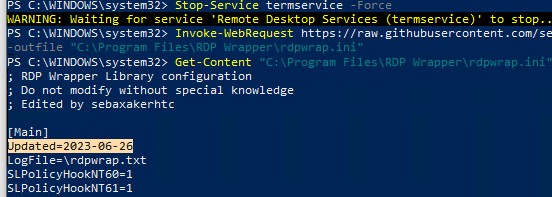
alert] Можно создать задание планировщика для проверки изменений в файле rdpwrap.ini и его автоматического обновления [/alert]
На данном скриншоте видно, что на компьютере установлена свежая версия файла rdpwrap.ini (Updated=2023-06-26).
Перезагрузите компьютер, запустите утилиту RDPConfig.exe. Проверьте, что в секции Diagnostics все элементы окрашены в зеленый цвет, и появилось сообщение [Fully supported]. На скриншоте ниже показано, что RDP Wrapper с данным конфигом успешно запущен в Windows 11 22H2.
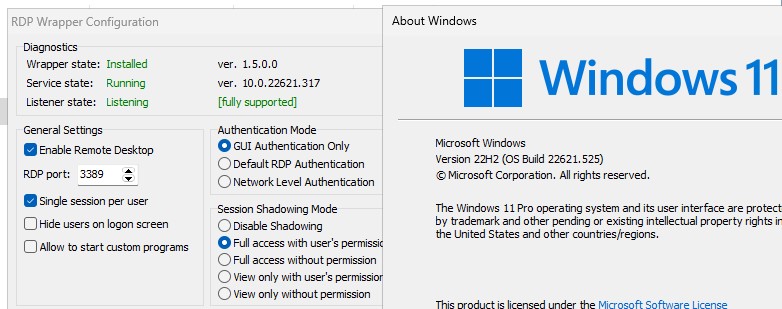
Теперь попробуйте установить несколько одновременных RDP сессий с этим компьютером под разными пользователями (воспользуйтесь любым RDP клиентом: mstsc.exe, RDCMan, mRemoteNG и т.д.).
Можете проверить что на компьютере активны одновременно две RDP сессии (или более) с помощью команды:
qwinsta
rdp-tcp#0 user1 1 Active rdp-tcp#1 user2 2 Active


Утилита RDPWrap поддерживается во версиях Windows (включая домашние редакции Windows Home), таким образом из любой клиентской версии Windows можно сделать полноценный сервер терминалов.
В интерфейсе RDP Wrapper доступны следующие опции:
- Enable Remote Desktop — включить/отключить Remote Desktop в Windows доступ
- RDP Port — можно изменить стандартный номера порта удаленного рабочего стола TCP 3389
- Опция Hide users on logon screen позволяет скрыть список пользователей на экране приветствия;
- Single session per user —разрешить несколько одновременных RDP сессий под одной учетной записью пользователя. Эта опция устанавливает параметр реестра fSingleSessionPerUser = 0 в ветке HKLM\SYSTEM\CurrentControlSet\Control\Terminal Server). Также этот параметр настраивается через опцию GPO Restrict Remote Desktop Services to a single Remote Desktop Services session в разделе Computer Configuration > Administrative Templates > Windows Components > Remote Desktop Services > Remote Desktop Session Host > Connections.
- В секции Session Shadowing Mode вы можете настроить режим теневого подключения к рабочему столу пользователей Windows .
Не работает RDP Wrapper в Windows
В некоторых случая утилита RDP Wrapper не работает как ожидается, и вы не можете использовать несколько RDP подключений.
Во время установки обновлений Windows может обновиться версия файла termsrv.dll. Если в файле rdpwrap.ini отсутствует описание для вашей версии Windows, значит RDP Wrapper не может применить необходимые настройки. В этом случае в окне RDP Wrapper Configuration будет указан статус [not supported].
В этом случае нужно обновить файл rdpwrap.ini как описано выше.
Если RDP Wrapper не работает после обновления файла rdpwrap.ini, попробуйте открыть файл rdpwrap.ini и найти в нем описание для вашей версии Windows.
Как понять, есть ли поддержка вашей версии Windows в конфиг файле rdpwrapper?
На скриншоте ниже показано, что для моей версии Windows 11 (10.0.22621.317) есть две секции с описаниями:
[10.0.22621.317] ... [10.0.22621.317-SLInit] ...
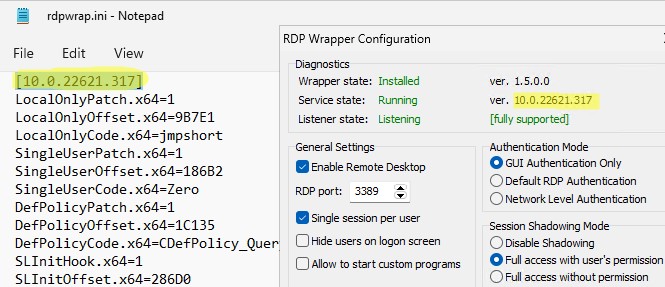
Если в конфигурационном файле rdpwrap соответствующая секция отсутствует для вашей версии Windows, попробуйте поискать в сети строки rdpwrap.ini для вашего билда. Добавьте найденные строки в самый конец файла.
Если после установки обновлений безопасности или после апгрейда билда Windows 10, RDP Wrapper не работает, проверьте, возможно в секции Diagnostics присутствует надпись Listener state: Not listening.
Попробуйте обновить ini файл, и затем переустановить службу:
rdpwinst.exe -u
rdpwinst.exe -i
Бывает, что при попытке второго RDP подключения под другим пользователем у вас появляется надпись:
Число разрешенных подключений к этому компьютеру ограничено и все подключений уже используются. Попробуйте подключиться позже или обратитесь к системному администратору.
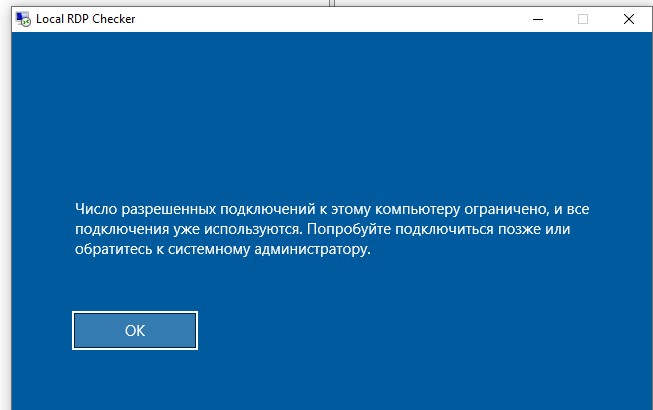
The number of connections to this computer is limited and all connections are in use right now. Try connecting later or contact your system administrator.
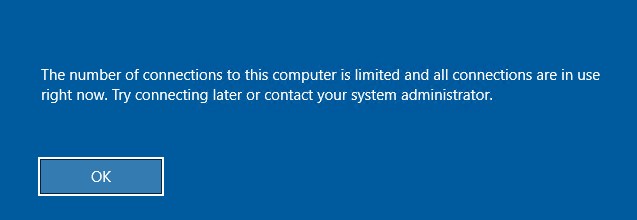
В этом случае нужно с помощью редактора групповых политики gpedit.msc в секции Конфигурация компьютера –> Административные шаблоны -> Компоненты Windows -> Службы удаленных рабочих столов -> Узел сеансов удаленных рабочих столов -> Подключения включить политику “Ограничить количество подключений” и изменить ее значение на 999999 (Computer Configuration -> Administrative Templates -> Windows Components ->Remote Desktop Services ->Remote Desktop Session Host -> Connections-> Limit number of connections).
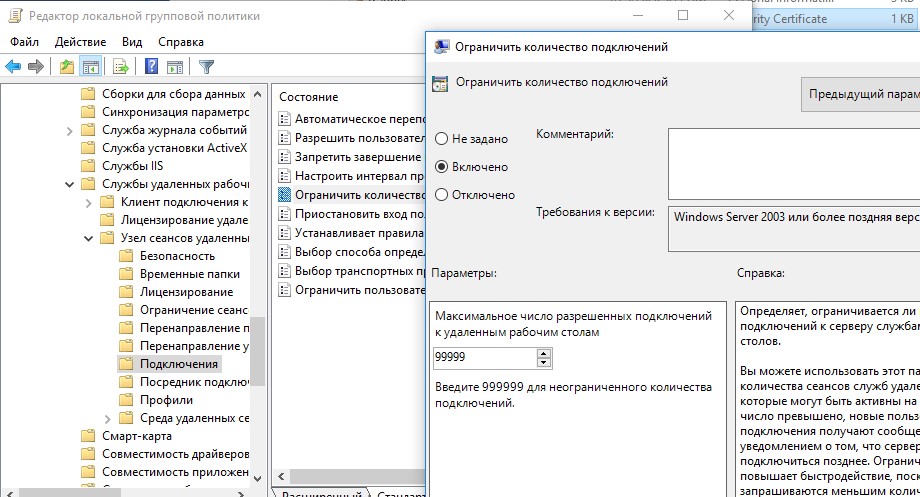
Перезагрузите компьютер для обновления настроек GPO и применения новых параметров.
Модификация файла termsrv.dll для снятия ограничений RDP в Windows 10 и 11
Чтобы убрать ограничение на количество RDP подключений пользователей в Windows без использования rdpwrapper нужно заменить файл termsrv.dll. Это файл библиотеки, которая используется службой Remote Desktop Services. Файл находится в каталоге C:\Windows\System32.
Прежде, чем править или заменять файл termsrv.dll желательно создать его резервную копию. Это поможет вам в случае необходимости можно будет вернуться к исходной версии файла. Запустите командную строку с правами администратора и выполните команду:
copy c:\Windows\System32\termsrv.dll termsrv.dll_backup
Затем нужно стать владельцем файла. Проще всего это сделать из командной строки. Чтобы сменить владельца файла с TrustedInstaller на группу локальных администраторов с помощью команды:
takeown /F c:\Windows\System32\termsrv.dll /A
Должно появится сообщение: «SUCCESS: The file (or folder): «c:\Windows\System32\termsrv.dll» now owned by the administrators group».
Теперь с помощью icacls.exe предоставьте группе локальных администраторов полные права на файл termsrv.dll (Full Control):
icacls c:\Windows\System32\termsrv.dll /grant Administrators:F
(или
Администраторы
в русской версии Windows).
Должно появится сообщение: «processed file: c:\Windows\System32\termsrv.dll Successfully processed 1 files; Failed processing 0 files«.

Теперь нужно остановить службу Remote Desktop Service (TermService) из консоли services.msc или из командной строки:
Net stop TermService
Вместе с ней останавливается служба Remote Desktop Services UserMode Port Redirector.
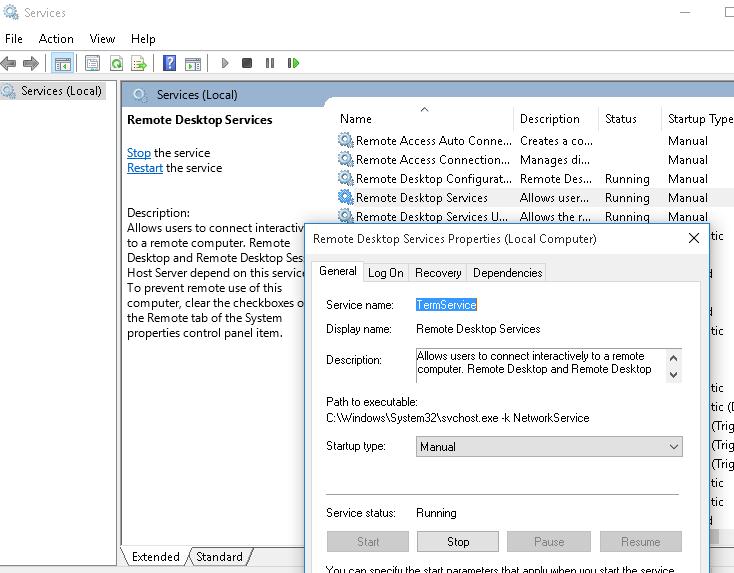
Чтобы узнать номер билда вашей Windows, выполните команду winver или следующую команды PowerShell:
Get-ComputerInfo | select WindowsProductName, WindowsVersion
В моем случае установлена Windows 10 билд 22H2.
Затем откройте файл termsrv.dll с помощью любого HEX редактора (к примеру, Tiny Hexer). В зависимости от билда нужно найти и заменить строку:
| Версия Windows | Найти строку | Заменить на |
| Windows 11 22H2 | 39 81 3C 06 00 00 0F 84 75 7A 01 00 |
B8 00 01 00 00 89 81 38 06 00 00 90 |
| Windows 10 22H2 | 39 81 3C 06 00 00 0F 84 85 45 01 00 | |
| Windows 11 RTM ( 21H2 22000.258) | 39 81 3C 06 00 00 0F 84 4F 68 01 00 | |
| Windows 10 x64 21H2 | 39 81 3C 06 00 00 0F 84 DB 61 01 00 | |
| Windows 10 x64 21H1 | 39 81 3C 06 00 00 0F 84 2B 5F 01 00 | |
| Windows 10 x64 20H2 | 39 81 3C 06 00 00 0F 84 21 68 01 00 | |
| Windows 10 x64 2004 | 39 81 3C 06 00 00 0F 84 D9 51 01 00 | |
| Windows 10 x64 1909 | 39 81 3C 06 00 00 0F 84 5D 61 01 00 | |
| Windows 10 x64 1903 | 39 81 3C 06 00 00 0F 84 5D 61 01 00 | |
| Windows 10 x64 1809 | 39 81 3C 06 00 00 0F 84 3B 2B 01 00 | |
| Windows 10 x64 1803 | 8B 99 3C 06 00 00 8B B9 38 06 00 00 | |
| Windows 10 x64 1709 | 39 81 3C 06 00 00 0F 84 B1 7D 02 00 |
Редактор Tiny Hexer не позволяет редактировать файл termsvr.dll напрямую из папки system32. Скопируйте его на рабочий стол, а после модификации замените исходный файл.
Например, для самой редакции Windows 10 x64 22H2 19045.2006 (версия файла termsrv.dll — 10.0.19041.1949) нужно открыть файл termsrv.dll в Tiny Hexer. Затем найдите строку:
39 81 3C 06 00 00 0F 84 85 45 01 00
И замените ее на:
B8 00 01 00 00 89 81 38 06 00 00 90
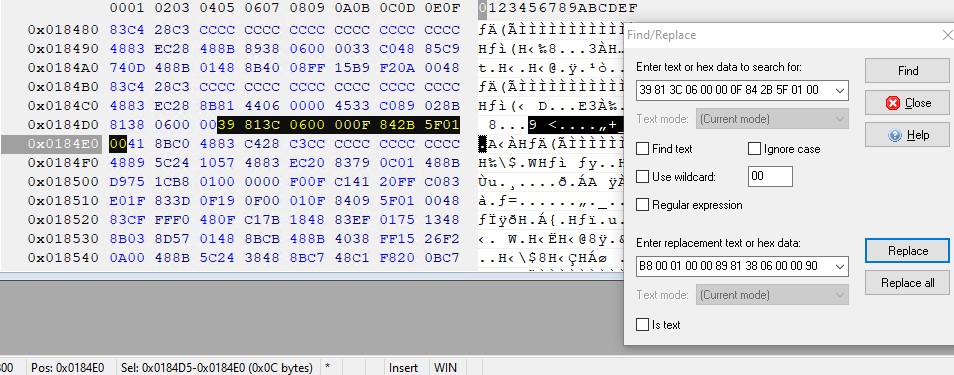
Сохраните файл и запустите службу TermService.
Если что-то пошло не так, и у вас возникнут проблемы со службой RDP, остановите службу и замените модифицированный файл termsrv.dll исходной версией:
copy termsrv.dll_backup c:\Windows\System32\termsrv.dll
Преимущество способа отключения ограничения на количество RDP сессий в Windows путем замены файла termsrv.dll в том, что на него не реагируют антивирусы. В отличии от утилиты RDPWrap, которую многие антивирусов считают Malware/HackTool/Trojan. Основной недостаток — вам придется вручную править файл после каждого обновления билда Windows (или при обновлении версии файла termsrv.dll в рамках ежемесячных кумулятивных обновлений).
Встроенная поддержка нескольких RDP сессий в редакции Windows 10 Enterprise Multi-session
Недавно Microsoft выпустило специальные Enterprise редакции Windows multi-session (ранее назывались Windows 10 Enterprise for Remote Sessions и Windows 10 Enterprise for Virtual Desktops).
Редакция Enterprise multi-session доступна как для Windows 10, так и для Windows 11.
Главная особенность этой редакции – она поддерживает множественные одновременные RDP сессии пользователей прямо из коробки. Несмотря на то, что редакцию Windows multi-session разрешено запускать только в виртуальных машинах Azure, вы можете вам установить эту редакцию в on-premises сети и использовать данный компьютер терминальный сервер (хотоя это будет нарушением лицензионной политики Microsoft).
Далее мы покажем, как обновить компьютер с Windows 10 Pro до Windows 10 Enterprise for Virtual Desktop и использовать его для одновременного подключения нескольких пользователей.
Откройте командную строку и проверьте текущую редакцию Windows (Professional в этом примере):
DISM /online /Get-CurrentEdition
Обновите вашу редакцию Windows с Pro до Enterprise:
Changepk.exe /ProductKey NPPR9-FWDCX-D2C8J-H872K-2YT43
Теперь установить GVLK ключ для Windows 10 Enterprise for Remote Sessions:
slmgr.vbs /ipk CPWHC-NT2C7-VYW78-DHDB2-PG3GK
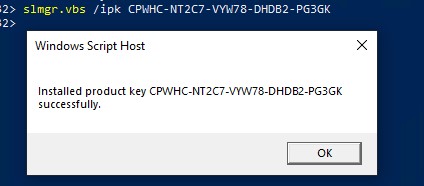
Проверьте, что теперь ваша редакция Windows 10 изменилась на
ServerRdsh
(Windows 10 Enterprise for Virtual Desktops).

Активируйте вашу копию Windows Enterprise Multi-Session на вашем KMS сервере:
slmgr /skms msk-man02.winitpro.local:1688
slmgr /ato
Откройте редактор локальной GPO
(gpedit.msc
) и включите Per-User режим лицензирования в параметре Set the Remote Desktop licensing mode (Computer Configuration -> Policies -> Administrative Templates -> Windows Components -> Remote Desktop Services -> Remote Desktop Session Host -> Licensing).
После активации нужно перезагрузить Windows. Теперь попробуйте подключиться к компьютеру по RDP под несколькими пользованиями. Как вы видите, Windows 10 Enterprise multi-session одновременные RDP подключения поддерживаются прямо из коробки.
Get-ComputerInfo | select WindowsProductName, WindowsVersion, OsHardwareAbstractionLayer
Windows 10 Enterprise for Virtual Desktops 2009 10.0.19041.2728
qwinsta
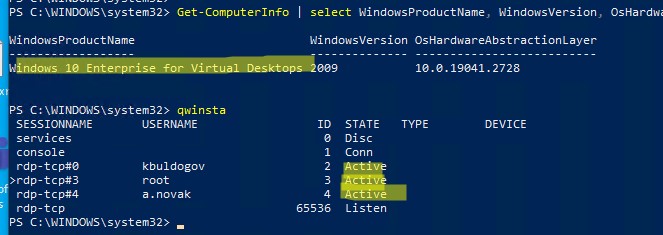
В этой статье мы рассмотрели способы, позволяющие снять ограничение на количество одновременных RDP подключений пользователей, и запустить бесплатный терминальный сервер на клиентской Windows 10 или 11. У каждого из этих способов есть свои преимущества и недостатки. Какой из них использовать — решать вам.
Удаленные пользователи могут подключаться к своим компьютерам с ОС Windows 10 и Windows 11 через службы удаленных рабочих столов (RDP). Достаточно включить RDP в настройках устройства и подключиться к компьютеру с помощью любого клиента удаленного рабочего стола, такого как MSTSC. Но существует ограничение на количество одновременных сеансов RDP – одновременно может работать только один удаленный пользователь. Если вы попытаетесь открыть второй сеанс RDP, появится предупреждение с просьбой отключить сеанс первого пользователя.
Изменения от 04.07.2023 г.
Настройка службы RDP на Windows 10
RDP работает только на Windows 10/11 Pro, в Home версии отключены нужные системные компоненты. Кроме этого, потребуется защитить паролем вашу учетную запись.
Включение доступа и добавление пользователей.
Откройте Пуск и нажмите на шестеренку Параметры.
Откройте раздел с настройкой системы.
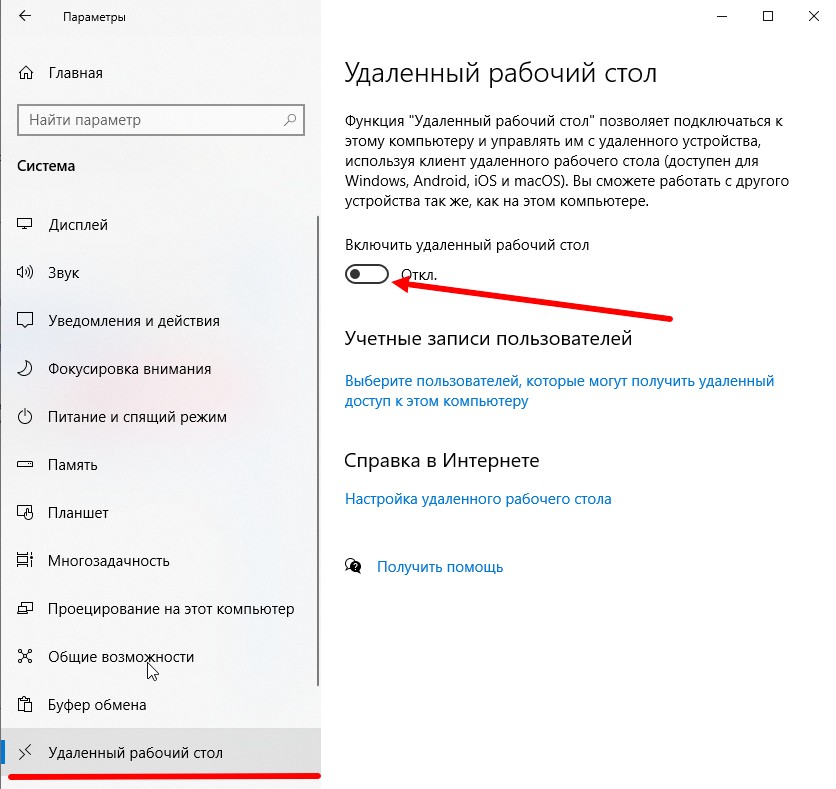
Далее перейдите к настройке удаленного рабочего стола.
Включить удаленный рабочий стол.
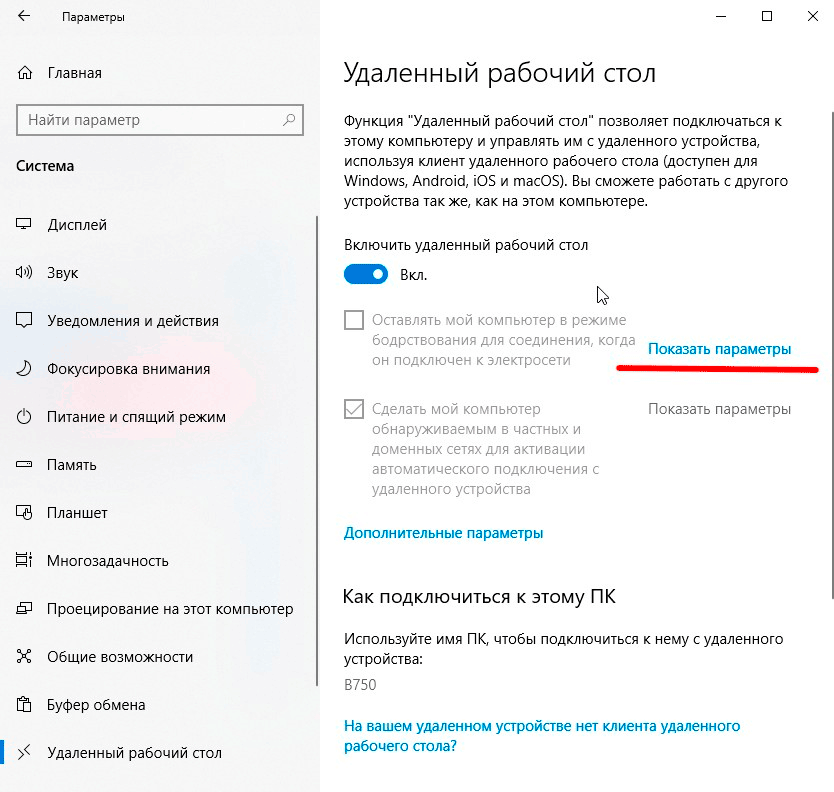
Перейти в настройки электропитания, отключить переход компьютера в спящий режим.
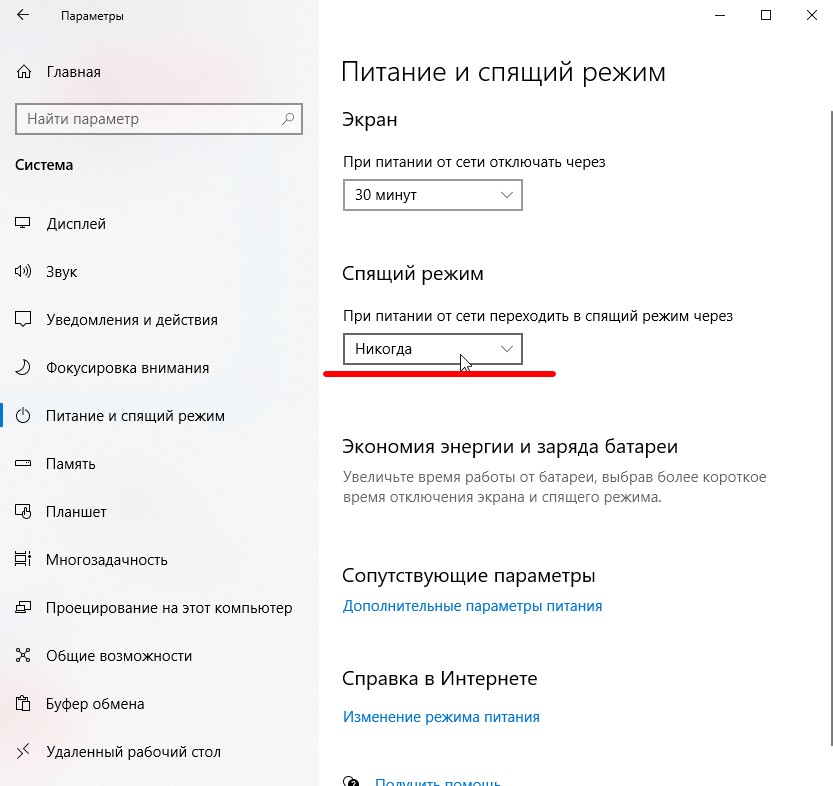
Далее необходимо пользователей, которым будет предоставлен доступ к RDP По умолчанию доступ предоставлен администратору компьютера.
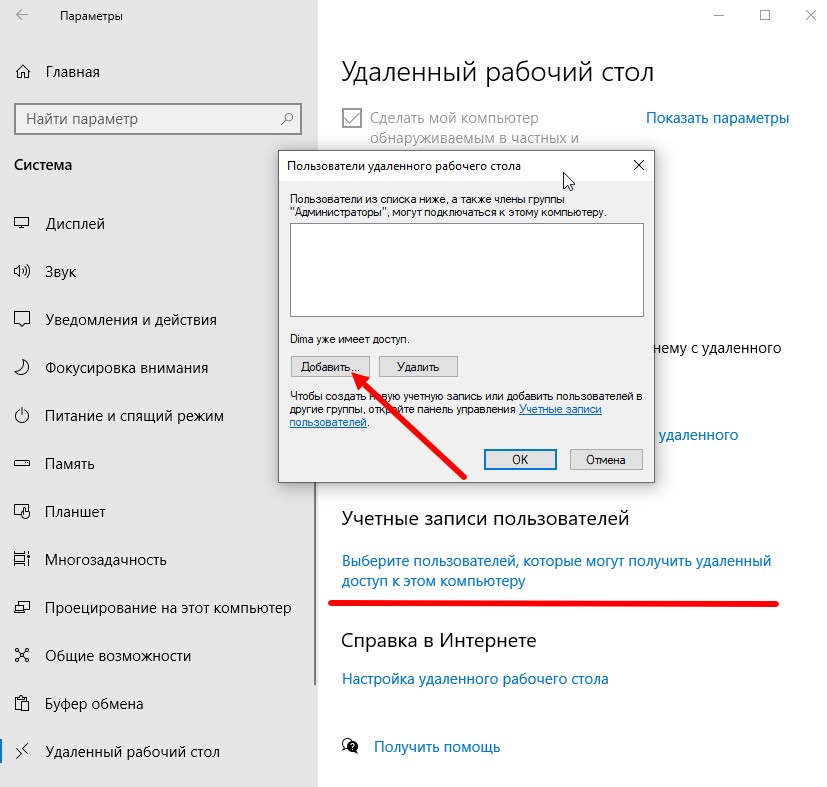
Добавляем еще пользователей.
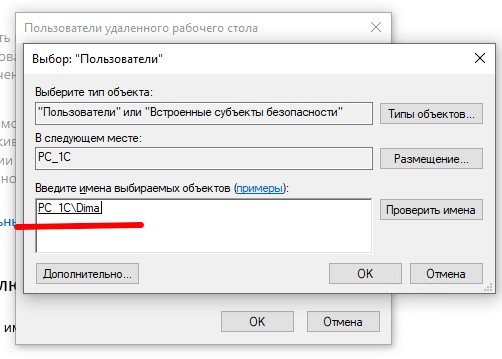
Если вы попытаетесь открыть второй сеанс RDP, появится предупреждение с просьбой отключить сеанс первого пользователя.
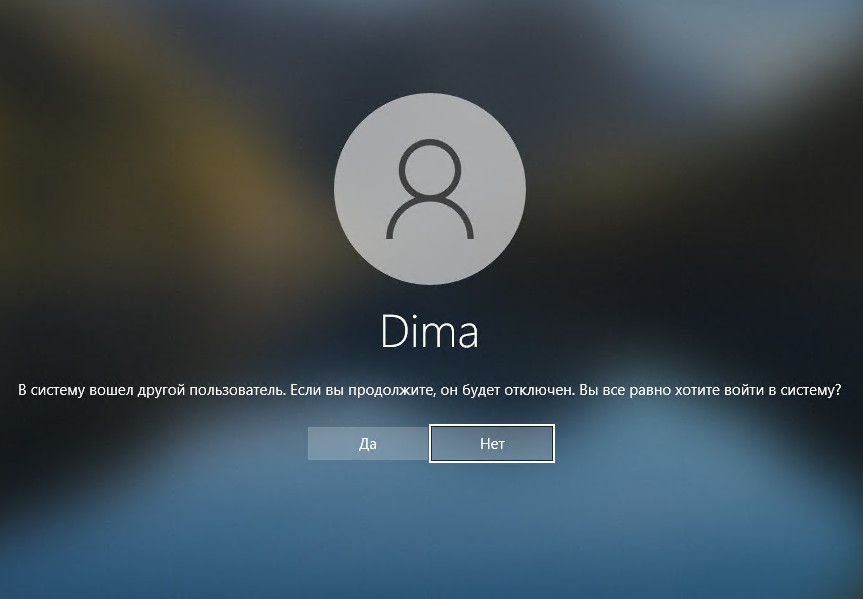
На самом деле, количество одновременных подключений RDP в системе Windows ограничено лицензией, а не каким-либо техническим аспектом. Таким образом, это ограничение не позволяет создать терминальный RDP-сервер на базе компьютера с системой Windows 10/11. Логика компании Microsoft проста, если вам нужен сервер терминалов – купите лицензию Windows Server, RDS CALs, установите и настройте роль сервера сеансов удаленного рабочего стола.
Но технически, любая версия Windows, с достаточным объемом оперативной памяти может поддерживать одновременную работу нескольких удаленных пользователей. В среднем, для одного сеанса пользователя, требуется около 200 МБ оперативной памяти (без учета запущенных приложений). Т.е. максимальное количество одновременных сеансов RDP теоретически ограничено только компьютерными ресурсами.
Рассмотрим два способа разрешить одновременные RDP-подключения в Windows 10/11:
- с помощью RDP Wrapper
- исправления библиотеки termsrv.dll
RDP Wrapper
Проект RDP Wrapper – ПО с открытым исходным кодом, позволяет включить несколько сеансов RDP в Windows 10 без замены файла termsrv.dll. Этот инструмент работает как связующее звено между SCM (Service Control Manager) и службами удаленного рабочего стола. RDPWrap позволяет включить не только поддержку нескольких одновременных RDP-подключений, но и создать RDP-сервер в Windows Home. RDP Wrapper не вносит никаких изменений в termsrv.dll файл, это просто загрузка библиотеки termsrv с измененными параметрами.
Таким образом, RDPWrap будет работать даже в случае изменения файла termsrv.dll. Это позволяет не бояться обновлений Windows.
Вы можете загрузить RDP Wrapper из репозитория GitHub https://github.com/binarymaster/rdpwrap/releases (последняя доступная версия библиотеки RDP-оболочки — v1.6.2).
В RDPWrap-v1.6.2.zip содержит несколько файлов:
- RDPWinst.exe — библиотека-оболочка RDP для установки/удаления программы
- RDPConf.exe — инструмент настройки оболочки RDP
- RDPCheck.exe — утилита проверки RDP (Local RDP Checker)
- Install.bat, uninstall.bat, update.bat — пакетные файлы для установки, удаления и обновления оболочки RDP
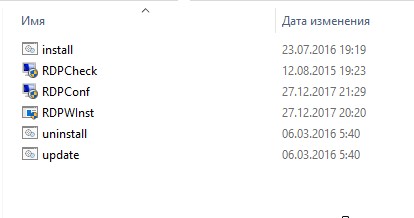
Для установки оболочки необходимо запустить файл Install.bat с правами администратора.
RDPWrap не работает в Windows 10
После завершения установки запустите RDPConfig.exe . Скорее всего, сразу после установки инструмент покажет, что оболочка RDP запущена (установлена, запущена), но не работает. Обратите внимание на красное предупреждение [not supported]. В нем сообщается, что эта версия Windows 10 (версия 10.0.19041.1387) не поддерживается оболочкой RDP.
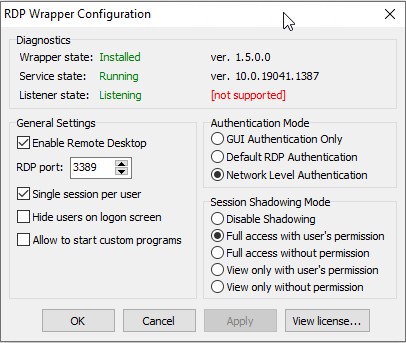
Дело в том, что для каждой версии Windows 10/11 должно быть описание в конфигурационном файле rdpwrap.ini. В текущем конфигурационном файле просто нет никаких настроек для вашей сборки Windows.
Текущую версию файла rdpwrap.ini можно загрузить здесь: https://raw.githubusercontent.com/sebaxakerhtc/rdpwrap.ini/master/rdpwrap.ini
Во всех источниках в интернете находятся советы, что необходимо скопировать новый файл rdpwrap.ini в “C:\Program Файл Files\RDP Wrapper\rdpwrap.ini” и перезапустить службу TermService. Но у меня это ни разу не получилось, ввиду того, что при перезапуске службы, оригинальный файл rdpwrap.ini восстанавливался на место нового.
Немного поискав решение этой проблемы, наткнулся на файл автоматического обновления rdpwrap.ini:
- С сайта GitHub
- С нашего сайта
Необходимо скопировать файлы RDPWinst.exe, RDPConf.exe, RDPCheck.exe и autoupdate.bat в каталог C:\Program Файл Files\RDP Wrapper\ и запустить autoupdate.bat.
После завершения установки запустите RDPConfig.exe
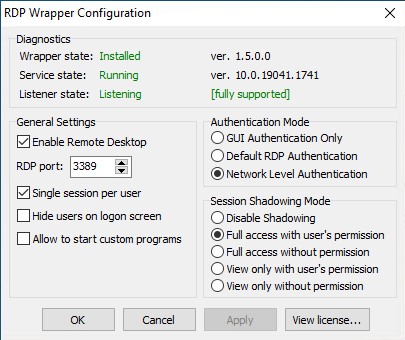
Все работает!
Обновление Параметров Групповой политики
Количество подключений к компьютеру может быть ограничено правилами групповой политики.
В этом случае вы можете использовать редактор локальной групповой политики (gpedit.msc), чтобы включить политику “Ограничить количество подключений” в разделе Конфигурация компьютера -> Административные шаблоны -> Компоненты Windows -> Службы удаленных рабочих столов -> Узел сеансов удаленных рабочих столов -> Подключения –> Ограничить количество подключений.
Измените его значение на 999999.
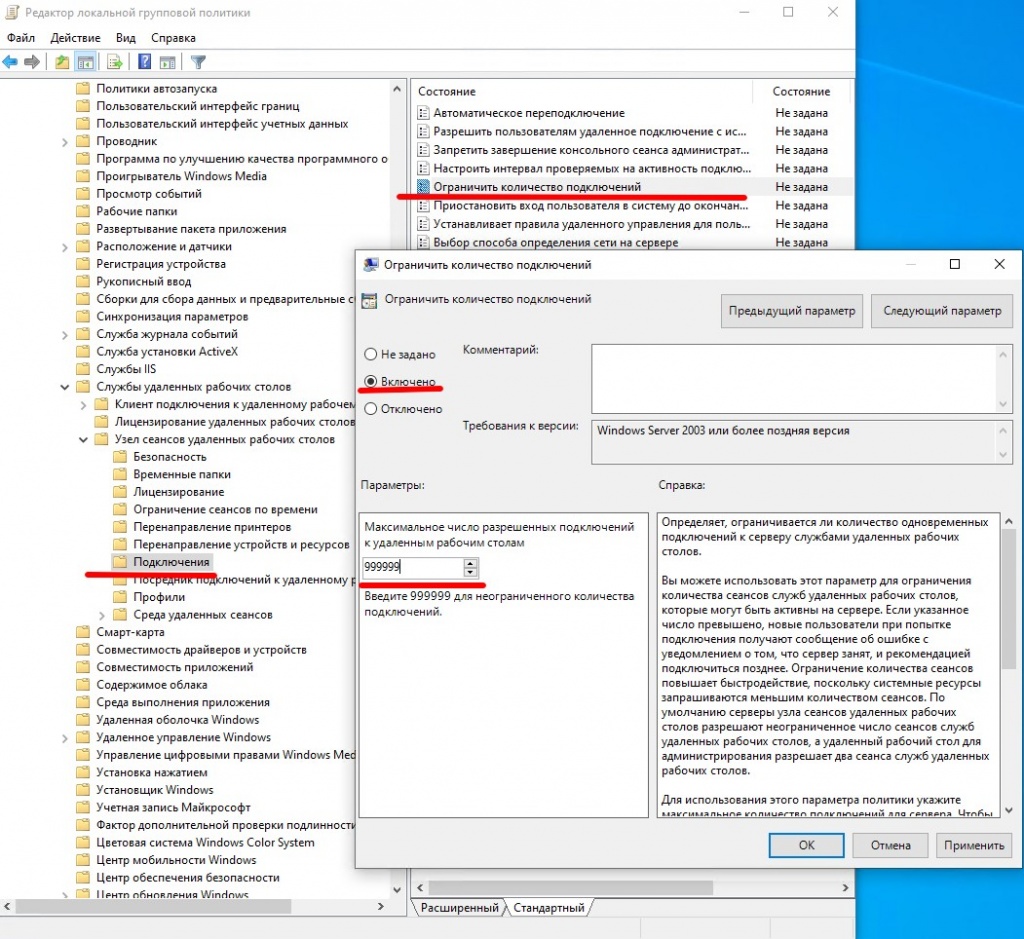
Модификация Termsrv.dll
Второй, более трудозатратный метод – изменение файла Termsrv.dll.
для этого нужно сделать копию файла, затем нужно стать владельцем файла.
Для начала, остановите службу удаленного рабочего стола (TermService) из командной строки:
Net stop TermService
Чтобы изменить владельца файла с TrustedInstaller на локальную группу администраторов нужно выполнить команду:
takeown /F c:\Windows\System32\termsrv.dll /A
Теперь предоставьте локальной группе администраторов разрешения на полный контроль над termsrv.dll файл с использованием icacls.exe:
icacls c:\Windows\System32\termsrv.dll /grant Администраторы:F
Затем откройте termsrv.dll файл с использованием любого шестнадцатеричного редактора (например, WinHex). В зависимости от вашей сборки Windows вам необходимо найти и заменить строку в соответствии с приведенной ниже таблицей:
| Версия Windows | Строка поиска |
|
Windows 11 RTM (21H2 – 22000.258) |
39 81 3C 06 00 00 0F 84 4F 68 01 00 |
|
Windows 10 x64 22H2 19045.2486 |
39 81 3C 06 00 00 0F 84 DB 61 01 00 |
|
Windows 10 x64 21H2 |
39 81 3C 06 00 00 0F 84 85 45 01 00 |
|
Windows 10 x64 21H1 |
39 81 3C 06 00 00 0F 84 2B 5F 01 00 |
|
Windows 10 x64 20H2 |
39 81 3C 06 00 00 0F 84 21 68 01 00 |
|
Windows 10 x64 2004 |
39 81 3C 06 00 00 0F 84 D9 51 01 00 |
|
Windows 10 x64 1909 |
39 81 3C 06 00 00 0F 84 5D 61 01 00 |
|
Windows 10 x64 1903 |
39 81 3C 06 00 00 0F 84 5D 61 01 00 |
|
Windows 10 x64 1809 |
39 81 3C 06 00 00 0F 84 3B 2B 01 00 |
|
Windows 10 x64 1803 |
8B 99 3C 06 00 00 8B B9 38 06 00 00 |
|
Windows 10 x64 1709 |
39 81 3C 06 00 00 0F 84 B1 7D 02 00 |
Строка замены
B8 00 01 00 00 89 81 38 06 00 00 90
Данную таблицу я нашел на просторах интернета. Проверка данного метода в полевых условиях привела к тому, что я не нашел данную последовательность в своем файле termsrv.dll.
Но если понять суть, то все решается достаточно легко. Необходимо искать последовательность: 39 81 3C 06 00 00 0F 84, последние 4 байта не особо важны.
Я нашел последовательность 39 81 3C 06 00 00 0F 84 73 55 01 00
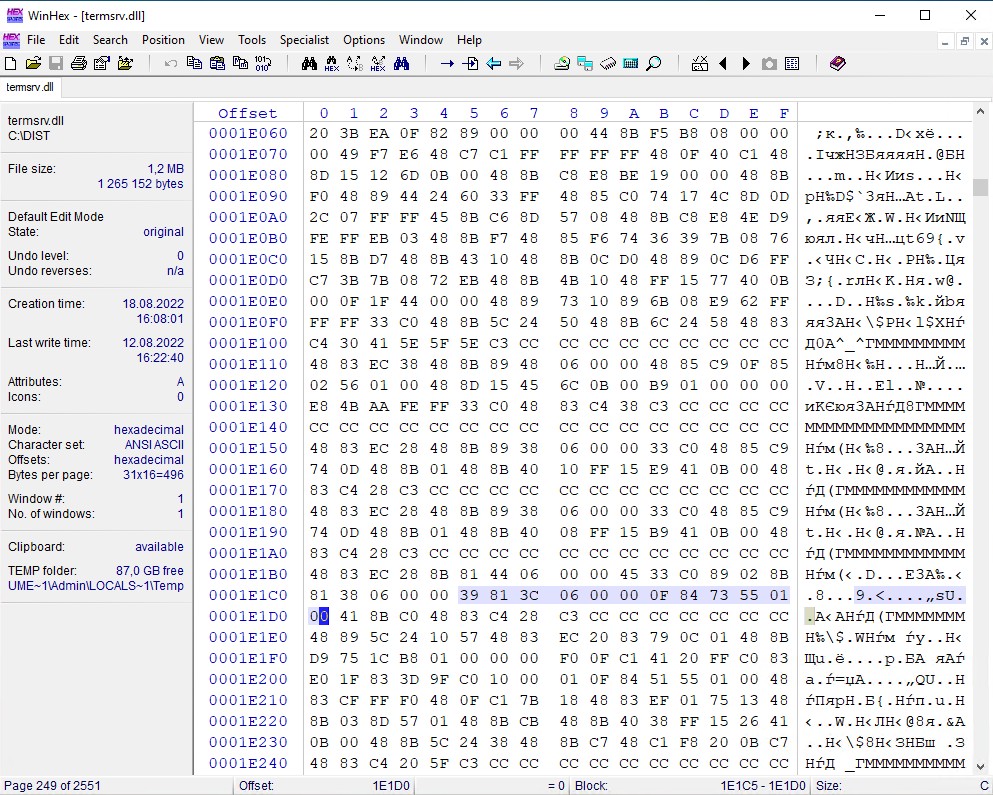
Замена на
B8 00 01 00 00 89 81 38 06 00 00 90
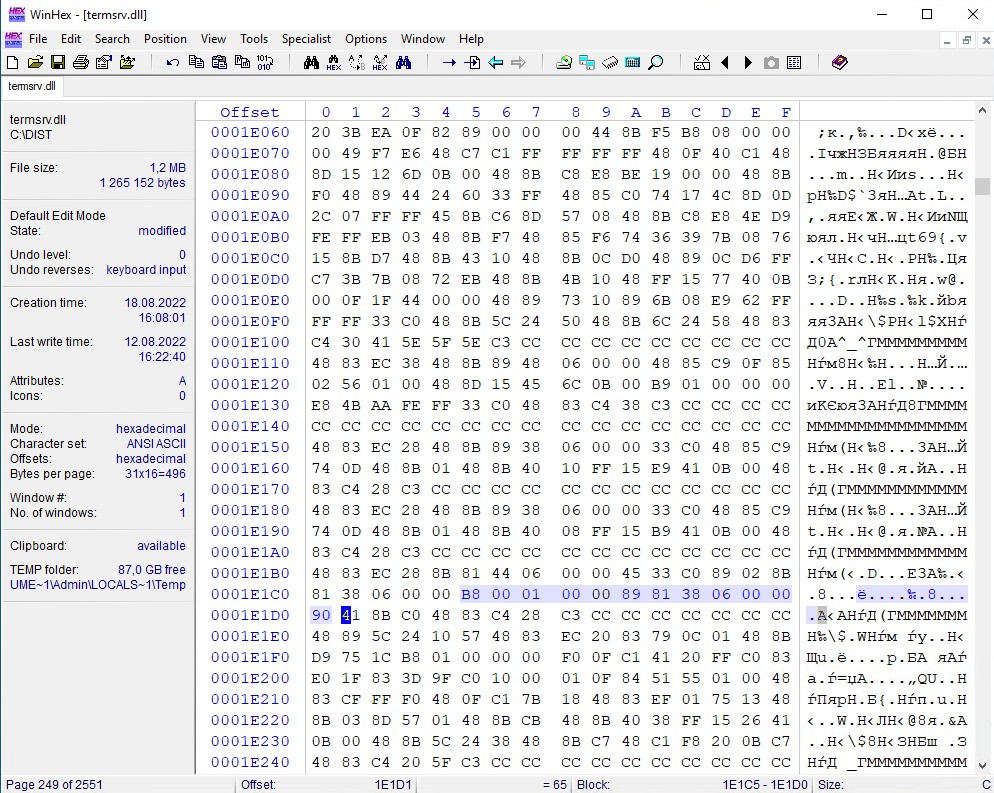
Обновление от 27.01.2023 г.
Вышло новое обновление Windows 10 22H2 версия сборки: 19045.2486 и 19045.2604
Версия файла termsrv.dll: 10.0.19041.2075
Открываем файл в WinHex, находим исходную последовательность: 39 81 3C 06 00 00 0F 84 85 45 01 00.
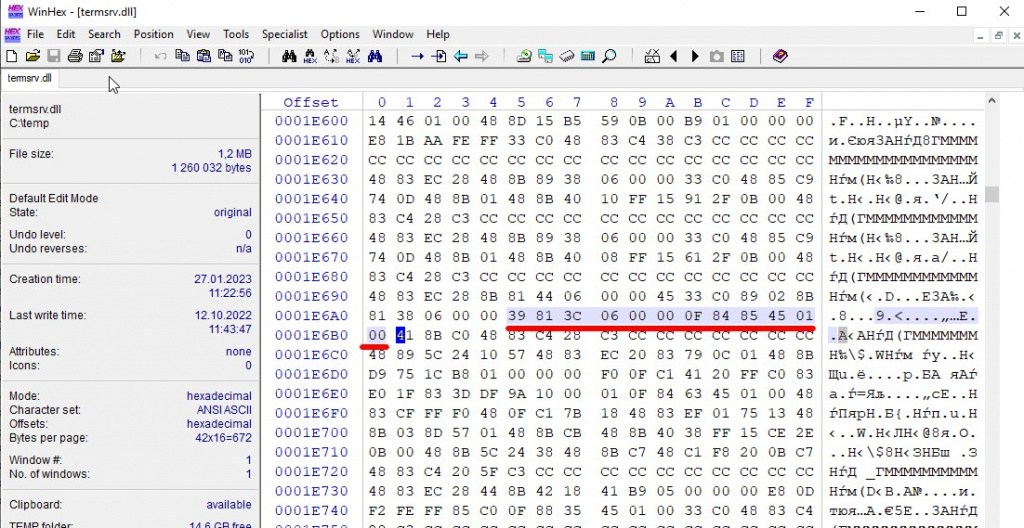
Меняем на строку замены.
Обновление от 04.07.2023 г.
Скачать измененный файл termsrv.dll для конкретной версии Windows 10 можно в данной таблице.
| Версия Windows | Скачать termsrv.dll |
|
Windows 10 x64 22H2 сборка 19045.2486 и 19045.2604 |
termsrv.dll |
|
Windows 10 x64 22H2 сборка 19045.3086 |
termsrv.dll |
Сохраните модифицированный файл и запустите службу TermService.
Если что-то пойдет не так, остановите службу и замените измененный termsrv.dll файл с оригинальной версией.
В моем случае модификация файла помогла включить несколько сеансов RDP.
Преимущество метода включения нескольких сеансов RDP в Windows 10 или 11 путем замены termsrv.dll файл заключается в том, что антивирусы на него не реагируют, в отличие от RDPWrap, который обнаруживается многими антивирусами как вредоносное ПО.
Основным недостатком является то, что вам придется вручную редактировать termsrv.dll файл при каждом обновлении сборки Windows 10/11. И если вы используете RDPWrap, вам также потребуется обновить файл rdpwrap.ini после установки обновлений Windows.
If you frequently access a remote Windows computer and get logged off because your colleague has logged on, and was unaware that you were logged on as well, then this article is for you.
By default, the Windows operating system only allows one RDP connection at a time. If another connection was made from another PC on the network, regardless if they use a different user account to sign in, you will be automatically logged off, and will get either one of the following prompts:
"You have been disconnected because another conenction was made to the remote computer"

Do you want to allow <computername/username> to connect to this machine? Click OK to disconnect your session immediately or click Cancel to stay conencted. No action will disconnect your session in 30 seconds.

Either way, both would not be allowed to be logged in on a remote PC simultaneously.
In this article, we address the issue of simultaneous RDP connections and how you can allow a client Windows PC (Windows 10 or 11) to have 2 or more RDP connections at the same time. This will increase your team’s productivity and save valuable time.
Before we begin, we would like to point out a few things.
Critical Considerations
Number one is that Microsoft wants you to use a Windows Server license instead of a Windows client license if you want to allow multiple RDP connections. This leads us to believe that the Windows OS does not technically lack any ability to be able to handle multiple RDP connections. Technically, it all comes down to the available system resources.
A typical RDP connection only requires 150-200 MBs of RAM per RDP session. If your system has the available RAM, you can allow multiple remote sessions using either one of the following methods stated below.
Secondly, we came across several websites that give a method to allow multiple RDP connections using the Group Policy editor by reconfiguring the “Restrict Remote Desktop Services user to a single Remote Desktop Services session” policy. Note that this method only works on Windows Servers.
Hence, do not waste your time editing the Group Policy, as we have already tested it out for you.
Thirdly, only the Professional and Enterprise Windows editions support RDP connections. If you have a Windows Home edition, then learn how to enable RDP or use the first method (RDPWrapper) to allow multi-user remote connection.
That being said, there is no native, straightforward method to allow multiple RDP connections on a client Windows PC. You either need to use a third-party utility or manipulate critical Windows files to enable multi-user RDP connection. Therefore, it is advised that you create a system restore point before proceeding forward with any of the two methods.
Enable Multiple RDP User Connections using RDPWrap
RDPWrap is an open-source project available on GitHub. RDPWrap enables support for numerous concurrent RDP sessions as well as RDP Hosts on previously inaccessible Windows editions, like Home.
Follow the steps below precisely as given to allow multiple RDP connections on the computer.
Note: All of the steps given below are to be performed on the remote (target) computer.
-
Download “RDPWInst.zip” from GitHub.
Note: If you are using Google Chrome to download the file, it will be flagged as malicious and blocked from downloading. Learn how to stop Chrome from blocking downloads.
-
Extract the contents of the zipped file.
Extract RDPWrap Right-click on the zipped file and click “Extract All” from the context menu. Then click “Extract” on the extraction wizard to finish the extraction.
-
Run “install.exe” with administrative privileges.
Run “install.exe” as administrator Right-click the “install.exe” file and then click “Run as administrator” from the context menu.
RDPWrap will now begin installation in a command window.
-
Press any key to continue the installation.
Press any key to finalize the installation -
Now run the “RDPConf.exe” file.
Run RDPConf.exe The RDP Wrapper Configuration window will now open.
-
Check that all elements in the Diagnostics section are green.
Ensure all elements are green Note that it states [Not Supported] in front of “Listener state” on the right. This is because the version of Windows would not be supported. To make RDPWrap support your OS version, you must replace the “rdpwrap.ini” file using the next few steps given below, which is located at “C:\Program Files\RDP Wrapper.”
-
Run an elevated PowerShell instance.
-
Run the following cmdlet:
Stop-Service termservice -ForceStop RDP service from PowerShell This will temporarily stop the Remote Desktop service.
-
Now run the following cmdlet to replace the rdpwrap.ini file:
Invoke-WebRequest https://raw.githubusercontent.com/sebaxakerhtc/rdpwrap.ini/master/rdpwrap.ini -outfile "C:\Program Files\RDP Wrapper\rdpwrap.ini"Replace the rdpwrap.ini file -
Restart the computer.
-
Run the “RDPConf.exe” file again to confirm that the status has changed from [Not Supported] to [Fully Supported].
RDPWrap is fully supported
That’s it! You should now be able to connect to the remote PC with multiple simultaneous connections using any RDP tool, like MSTSC, Microsoft RDP, rdcman, etc. However, you can only sign in using different local user accounts.
If you sign in with the same user account, the RDC connection using the account prior will be automatically disconnected.
Enable Multiple RDP User Connections by Modifying Termsrv.dll
If you do not wish to use RDPWrap, then you can modify the Termsrv.dll file to allow multiple RDP connections at the same time. This is the library the Remote Connection Protocol uses to establish a connection and is located at “C:\Windows\System32.”
Let us remind you to create a system restore point before proceeding, so you can revert your settings if things do not go as planned.
Alternatively, we have also given steps to back up only the Termsrv.dll in the steps below so it can be replaced when needed.
Perform the following steps to modify the Termsrv.dll library and allow multiple RDP connections:
Note: All of the steps given below are to be performed on the remote (target) computer.
-
Launch an elevated Command Prompt.
-
Make a copy of the Termsrv.dll file by running this cmdlet:
copy c:\Windows\System32\termsrv.dll termsrv.dll_backupBackup termsrv.dll -
Take ownership of the original file by running the following command:
takeown /F c:\Windows\System32\termsrv.dll /ATake ownership of Termsrv.dll -
Grant the local Administrator group full control of the library by running this cmdlet:
icacls c:\Windows\System32\termsrv.dll /grant Administrators:FGrant the Administrator group full control of Termsrv.dll -
Now stop the Remote Desktop service by running this cmdlet:
Net stop TermServiceAlso, enter “Y” when asked for confirmation.
Stop the RDP service -
Determine and note down your OS version by typing in “winver” in the Run Command box.
Find your OS version This will be needed later.
-
Now open the termsrv.dll file (C:\Windows\System32\termsrv.dll) using a Hex editor.
You can download any hex editor online.
-
Search for the following string according to your OS version (determined in step 6 above) given in the table below and replace it with the following:
B8 00 01 00 00 89 81 38 06 00 00 90
Windows build String to replace Windows 11 22H2 39 81 3C 06 00 00 0F 84 75 7A 01 00 Windows 11 RTM (21H2 – 22000.258) 39 81 3C 06 00 00 0F 84 4F 68 01 00 Windows 10 x64 21H2 39 81 3C 06 00 00 0F 84 DB 61 01 00 Windows 10 x64 21H1 39 81 3C 06 00 00 0F 84 2B 5F 01 00 Windows 10 x64 20H2 39 81 3C 06 00 00 0F 84 21 68 01 00 Windows 10 x64 2004 39 81 3C 06 00 00 0F 84 D9 51 01 00 Windows 10 x64 1909 39 81 3C 06 00 00 0F 84 5D 61 01 00 Windows 10 x64 1903 39 81 3C 06 00 00 0F 84 5D 61 01 00 Windows 10 x64 1809 39 81 3C 06 00 00 0F 84 3B 2B 01 00 Windows 10 x64 1803 8B 99 3C 06 00 00 8B B9 38 06 00 00 Windows 10 x64 1709 39 81 3C 06 00 00 0F 84 B1 7D 02 00 Windows versions and corresponding hex string to replace Find and replace hex values in Termsrv.ini -
Make the changes and save the Termsrv.dll file.
Save the modified Termrv.dll file -
If prompted for confirmation or UAC, click Yes.
-
Close the hex editor.
You should now be able to connect multiple RDP sessions to the remote PC after modifying the Termsrv.dll file.
If things didn’t go as planned, you can restore the original Termsrv.dll file by running the following cmdlet in Command Prompt using the backup we had created in step 2 above:
copy termsrv.dll_backup c:\Windows\System32\termsrv.dllConclusion
Having the ability to have multiple RDP connections simultaneously on a Windows PC can result in a significant increase in productivity. Now, you and your team members can work on a client Windows PC at the same time, without having to wait on one another.
That said, the methods given in this post are tried-and-tested and you can perform them word-for-word on your Windows PC to allow simultaneous RDP sessions. However, even though the methods work, we advise you to create system backups just in case.
With the growing trend toward remote work and resource-sharing, companies are constantly looking to maximize their hardware investment while minimizing costs.
For small businesses, setting up dedicated servers can be costly and complex, while having multiple team members access one machine can streamline workflows, reduce equipment needs, and cut down on software licensing expenses.
However, these users quickly discover that Windows 10, as a client-based operating system, lacks built-in multi-user support, leading many to seek workarounds that simulate the functionality of more expensive solutions like Windows Server.
This detailed guide provides comprehensive methods to enable multiple simultaneous users on a single Windows 10 machine.
IN THIS GUIDE
Windows 10 Limitations
Method 1: Using RDP Wrapper for Concurrent Remote Desktop Sessions
Method 2: Modifying the termsrv.dll File for Multi-User Access
Method 3: Using Third-Party Remote Access Tools for Simultaneous User Access
Recommended Method: V2 Cloud Virtual Desktop Solution
WordPress Table of Contents by Topic
Windows 10 Limitations
Windows 10, like other client versions of Windows (such as Windows 7 and 8), is inherently designed for single-user access. Microsoft has reserved true multi-user functionality—where several users can access the system simultaneously—for its Windows Server editions.
On Windows 10, when a new user logs in remotely, the active user is automatically logged out, limiting simultaneous access. This design also extends to physical access, meaning only one user can interact with the system locally, making it unsuitable for shared real-time use in most business scenarios.
These limitations force businesses and IT users to either switch to Windows Server or explore alternative methods for multi-user access.
Can Multiple Users Simultaneously Use Windows 10?
No, Windows 10 does not support true simultaneous multi-user access. Unlike Windows Server, which is designed for multiple users to log in and work at the same time, Windows 10 allows only one active user per session.
If someone connects remotely using a Remote Desktop Connection (RDC), it automatically logs out the local user, enforcing single-user access. While you can switch between user profiles on the same device, only one user can be active at any moment.
This single-user design means that for real-time, concurrent sessions, businesses need to consider alternatives like Windows Server or virtual desktop solutions like V2 Cloud, which provide safe, multi-user access without system limitations.
Enabling multiple users to access Windows 10 simultaneously requires workarounds, as it’s not natively supported. Below are methods to achieve multi-user functionality. However, some of these methods involve technical modifications and may affect system security.
Method 1: Using RDP Wrapper for Concurrent Remote Desktop Sessions
The RDP Wrapper tool is an open-source project that enables multiple Remote Desktop sessions on Windows 10 without directly modifying the system’s termsrv.dll file. It creates a layer between Windows services and the Remote Desktop Service, allowing simultaneous remote sessions.
This method is less invasive and doesn’t require editing system files.
Note: RDP Wrapper may need periodic updates to remain compatible with future Windows updates, as changes to termsrv.dll can disrupt its functionality.
1. Download the RDP Wrapper Library
- Go to the RDP Wrapper GitHub page and download the latest RDP Wrapper release.
- Scroll down to the “Assets” section, and download the .zip file containing the RDP Wrapper Library.

2. Extract the Files
- Extract the downloaded .zip file. You should see several files, including:
- install.bat
- uninstall.bat
- RDPConf.exe
- RDPCheck.exe.

3. Run the Installer
- Right-click on install.bat and select Run as administrator. This will install RDP Wrapper and allow concurrent RDP sessions.
- By default, the installer places files in C:\Program Files\RDP Wrapper.
- On completion, the onscreen information will display Successfully installed, as seen in the picture below.

4. Check the Diagnostic Status
- Click on the RDPConfig.exe to open the RDP Wrapper Configuration. This will show the Diagnostic section indicating whether the RDP Wrapper is installed, running, listening, and supported.
- On first accessing the application after installation, the Diagnostic section will show that the RDP Wrapper is Installed, Running, and Listening but not supported.
- Follow the steps below to ensure all elements shown in the Diagnostic section are green.
- Navigate to the Githubusercontent website.
- Copy the content on the page.
- Navigate to C: Program FilesRDP Wrapperrdpwrap.ini.
- Paste the content on the page.
- Restart your computer.
- Run the RDPConfig.exe tool again.
- Check if all items are now green.
5. Test the Configuration with RDPCheck
- Run RDPCheck.exe as an administrator to test that multiple users can connect remotely.
- This tool will allow you to initiate a second Remote Desktop session on the machine, confirming that the RDP Wrapper is functioning correctly.

Method 2: Modifying the termsrv.dll File for Multi-User Access
Another way to enable multi-user sessions in Windows 10 is by directly modifying the termsrv.dll file, which controls Remote Desktop limitations. This method requires making advanced changes to system files and registry entries and should be done carefully.
Caution: Editing system files directly can destabilize your system and potentially violate Microsoft’s licensing agreements. This method is best suited for advanced users.
1. Stop Remote Desktop Services
- Press Win + R to open the Run dialog box. Type services.msc and hit Enter.
- Find Remote Desktop Services in the list, right-click, and select Stop. This step is necessary to prevent conflicts when modifying termsrv.dll.

2. Backup the termsrv.dll File
- Run Command Prompt as Administrator. To do this, type “cmd” in the Start menu, right-click on Command Prompt, and select Run as administrator.
- Enter the command copy c:\Windows\System32\termsrv.dll termsrv.dll_old to back up the original termsrv.dll file.

3. Make Registry Changes
- Open the Registry Editor by pressing Win + R, typing regedit, and pressing Enter.
- Navigate to Computer\HKEY_LOCAL_MACHINE\SYSTEM\CurrentControlSet\Control\Terminal Server.
- Find the entries fDenyTSConnections and fSingleSessionPerUser and set both values to 0. This change enables multi-session support.

4. Change Ownership and Permissions on termsrv.dll
- Navigate to C:\Windows\System32, locate termsrv.dll, and right-click to open Properties.
- Go to the Security tab, select Advanced, and change the owner to your Administrator account.
- Grant Full Control permissions to the Administrators group. This will allow you to replace the file with a modified version.
5. Edit the termsrv.dll File
- Using a HEX editor, open termsrv.dll and locate the specific code that enforces session limits. Replace this code with a patch that enables multiple sessions (patches and code strings can be found online, but always use verified sources).
- Save the modified file and replace the original termsrv.dll in C:\Windows\System32.
6. Restart Remote Desktop Services
- Return to the Services console (services.msc), right-click Remote Desktop Services, and select Start.
- Test the configuration by connecting multiple users remotely to see if concurrent sessions are enabled.

Method 3: Using Third-Party Remote Access Tools for Simultaneous User Access
For a simpler and safer option, third-party remote access software like TeamViewer, AnyDesk, or Splashtop allows multiple users to access the same Windows 10 device in independent sessions.
These applications create virtual sessions that don’t require modifications to system files, making them secure and easy to implement.
Considerations: While easy to set up, these tools typically require a stable internet connection and may incur subscription costs for business use.
1. Download and Install the Software
- Visit the official website of TeamViewer, AnyDesk, or another remote access tool, and download the latest version.
- Install the software on the Windows 10 machine that you want to access.
2. Create User Accounts (Optional)
- Some tools, like TeamViewer, allow you to create separate accounts for each user. This ensures each user has individual access and can log in concurrently.
3. Configure Access Permissions
- In the application’s settings, set permissions for each user as needed. These permissions can control whether users have full control, view-only access, or limited interaction capabilities.
- Ensure each user has a unique login, which allows them to access the desktop remotely without interrupting each other’s sessions.
4. Test Multi-User Access
- Have multiple users log in remotely to verify that they can each interact with the system independently.
Recommended Method: V2 Cloud Virtual Desktop Solution
For a reliable, multi-user solution that doesn’t require complex setups or risky modifications, V2 Cloud provides a secure, virtual desktop environment with true multi-user support.
V2 Cloud hosts your desktops in the cloud, allowing multiple users to log into a virtual Windows environment that mirrors a physical workstation but without the limitations of Windows 10.
Why Choose V2 Cloud?
- True Multi-User Functionality: Multiple users can access the same cloud desktop simultaneously, each with a unique, secure session.
- Simple Management and Setup: V2 Cloud’s intuitive interface makes setup easy, and there’s no need to modify system files.
- Enhanced Security and Performance: With V2 Cloud, you get enterprise-level security, automatic backups, and high performance without compromising stability.
For businesses and IT teams needing multi-user access, V2 Cloud provides a secure, scalable solution without the limitations of Windows 10. Talk to a Cloud Expert to experience effortless multi-user access with powerful virtual desktop technology.
Introduction
In windows we can access the Remote Desktop by using a remote desktop app provided by the windows. Windows 10 multiple user remote desktop. In order to successfully access the remote desktop we first need to do some simple setting in : Remote Desktop setting we have to enable the “Enable Remote Desktop” option. Then by using the Desktop name you can access the remote desktop.
But when we try to access the remote computer with simple settings currently active user on the remote computer can not access the remote computer. If a remote computer has multiple user accounts on the computer then we can access the other user without disturbing currently active users on the remote computer i.e. we can make remote desktop connections for multiple users without disturbing currently active user.
How to do it?
To allow multiple remote desktop connections we need to modify the termsvrl.dll which restricts the number of RDP (Remote Desktop Protocol) connections to one. There are two methods developed to enable the multiple RDP session without disturbing currently active user of remote desktop.
- Modifying termsvrl.dll
- RDP Wrapper Library
In this tutorial we will study the second method to allow multiple RDP sessions on windows 8 or 10.
What is RDP Wrapper Library :
RDP Wrapper is a free open source project to enable Remote Desktop Host support and allow us to access remote desktop connections for multiple users without disturbing currently active user. It works as a layer between Service Control Manager and Terminal Services, so we can access the remote desktop without modifying the original termsrv.dll file.
To use the RDP wrapper you must have the original termsrv.dll if you have made some changes or patched it before, it may not work or it will crash any time. So take care of that.
Steps to allow multiple RDP session (using RDP Wrapper Library) :
Step 1. Download RDP Wrapper Library
https://github.com/stascorp/rdpwrap/releases (v1.6).
Step 2. Open RDPWrap-v1.6.2.zip

RDPWrap-v1.6.2.zip archive contains some files:
RDPWinst.exe — an RDP Wrapper Library install/uninstall program
RDPConf.exe — an RDP Wrapper configuration utility
RDPCheck.exe — Local RDP Checker
install.bat, uninstall.bat, update.bat — batch files for installation, uninstallation and update of RDP Wrapper
Step 3. Install RDPWrapper
Open install.bat file with the Administrator privileges. It will install the RDP Wrapper.
Step 4. Configure RDPWrapper
Open RDPConf.exe with Administrator privileges. Windows 10 multiple user remote desktop Make sure that all elements in the Diagnostics section are green. (If your all elements in the Diagnostic section are in the green then you are ready to connect the remote desktop )
If service state is Stopped
Check TermService is not stopped. To start TermService try command
net start termservice
If version is [ not supported]
- Update the rdpwrap.ini
In order to update the rdpwrap.ini file, you first need to stop the RDP service, otherwise you will get an ‘access denied’ error or similar. - you need to patch your rdpwrap.ini configuration file. You will find the file here: C:\Program Files\RDP Wrapper\rdpwrap.ini.
- First Stop the RDP service. For that use command
net stop termservice
- Download the updated rdpwrap.ini from here:
https://github.com/stascorp/rdpwrap/files/3078951/rdpwrap.zip - For build 18363.836 follow https://github.com/stascorp/rdpwrap/issues/1083
- Download the zip file and overwrite your current file
- Now start the the RDP service. For that use command
net start termservice
Note: If still rdpwrap.ini version is [ not supported] then try another version of rdpwrap.ini. You will get a different file of rdpwrap.ini on github. For me the above file is worked.
Step 5: Setting of RDPWrapper
Security mode: Network Level Authentication
Network Level Authentication decides the user’s credentials from the client through a client-side Security Support Provider and It do the authenticate before establishing a session on the server. Network Level Authentication was introduced in RDP 6.0 .
single user per session
A user will have the same view of desktop/running apps whether its login directly from the console, or (later) logging in through remote desktop. Obviously only one session for that user can be connected at the same time.
Apply the changes
Step 6: Save the changes and reboot.
Step 7:Connect to remote desktop
Now try to connect the Remote Desktop. And access the user which is currently not working. This way you can access the remote desktop without disturbing currently active user.
Conclusion:
This way by modify the termsvrl.dll which define the number of RDP session you can allow remote desktop connections for multiple users on windows 10 or 8.

